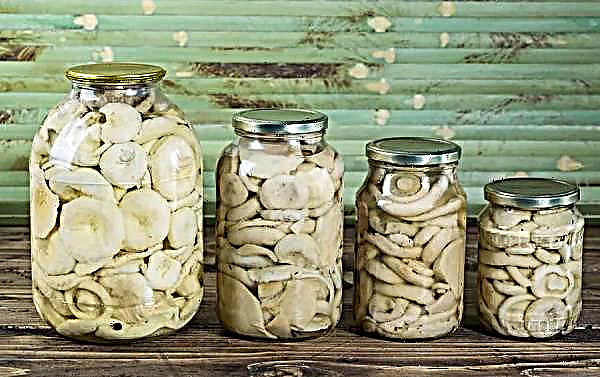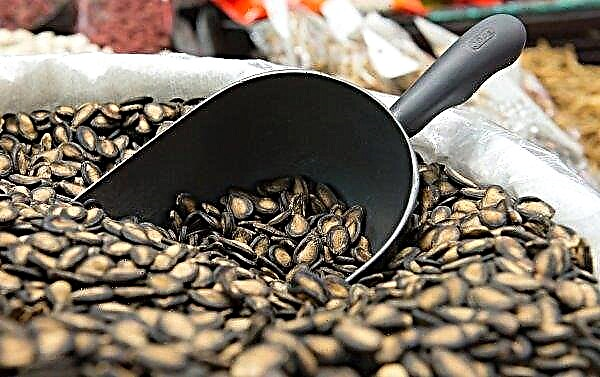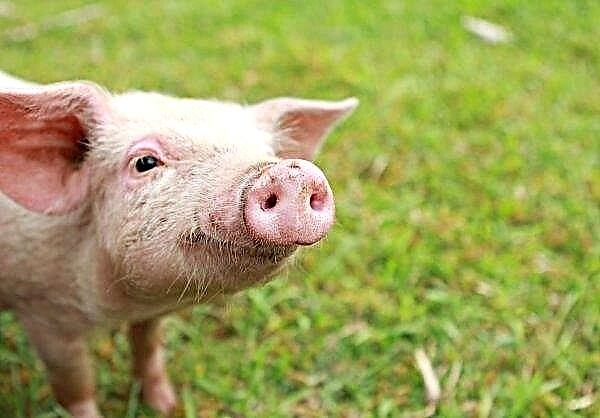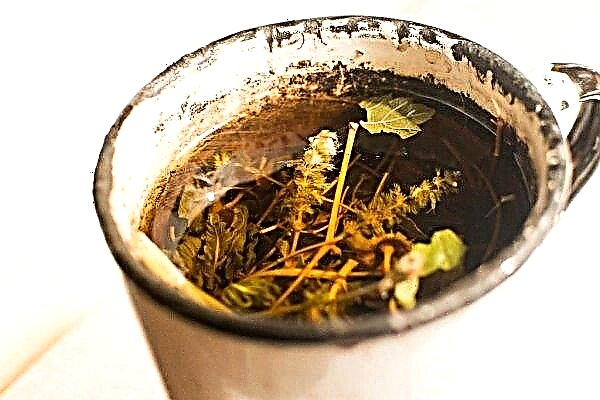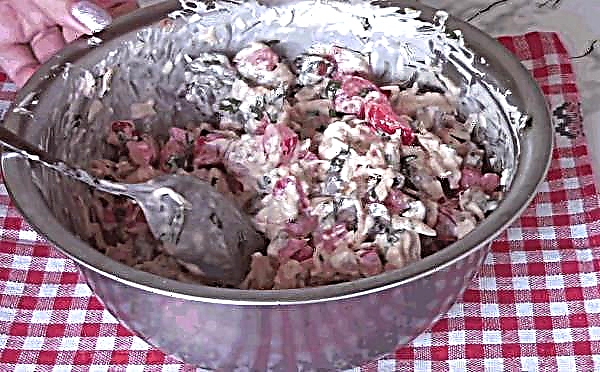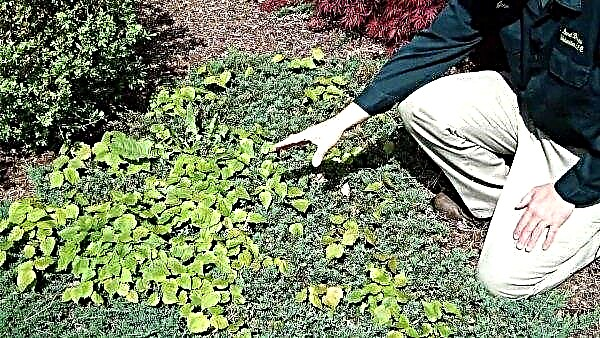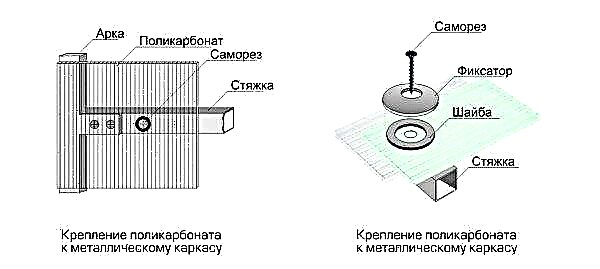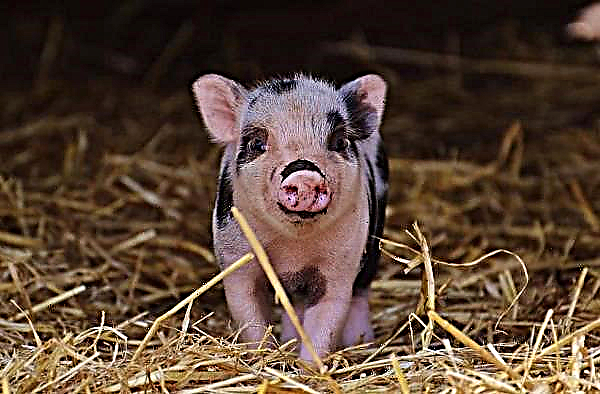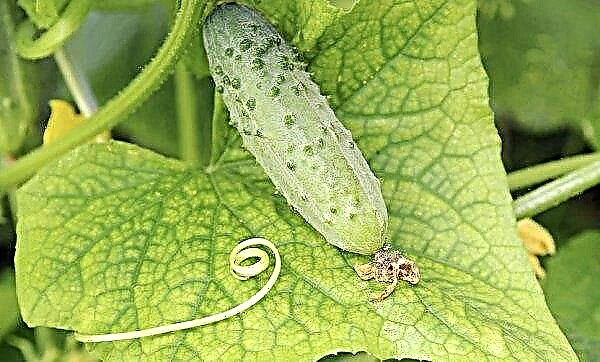Japanese garden azalea in our latitudes is cultivated mainly in apartment conditions - the plant is rather capricious and requires careful care. How to implement it and what conditions are needed to make the plant feel comfortable, read below.
Japanese Azalea: features of the plant
Azaleas unite an extensive group of plants of the genus rhododendrons of the heather family. Breeding work aimed at improving the adaptive abilities of plants began in the XX century. The representative of the Far Eastern region was taken dull rhododendron. The birthplace of the plant is Japan. In the wild, azaleas are dense, semi-evergreen shrubs reaching a height of 1.5 m. At home they are used as hedges and borders in the design of landscape compositions.
Did you know? On one azalea bush, up to 500 buds can open at a time.
In the classical gardens of Japan, they are subjected to a decorative haircut, and even to the detriment of flowering. The smallest varieties of azaleas grow only up to 30 cm. Regardless of varietal affiliation, all the bushes have a beautifully pressed shape, which makes them look like a pillow. The annual growth in plants is small, only 7 cm; Despite this, the bushes branch well. They are covered with small beautiful leaves up to 2 cm long. The structure of the sheet plates may be leathery, smooth or fleecy.
Flowering begins in May – June; in the same period, new leaves begin to grow. Abundant flowering flowers are arranged so often that leaves are not visible under them. The flowering phase lasts 2-3 weeks. Flowers vary greatly in size in different varieties. The smallest have a diameter of 2.5 cm, the largest - 7.5 cm.Flowers may be:
- simple;
- terry;
- wide open;
- half-open;
- rounded
- elongated.
Most often, azalea flowers are painted in shades of red of varying intensity. Less common are snow-white, violet and yellow specimens.
Varieties of azalea japanese
Popular varieties of Japanese azaleas:
- Golden light - tall bushes from 1.5 to 1.75 m. The width of the bushes is usually 1.5 m. They grow slowly. They have a pillow shape. The leaves are green, leathery. Flowering occurs in late May and lasts until mid-June. The flowers are golden in color. The variety is frost-resistant, perfectly adaptable in any climatic conditions.
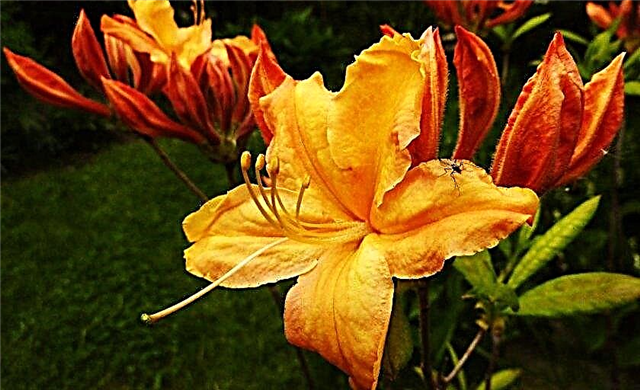
- Marushka - dwarf culture, semi-evergreen. The silhouette of the bush is pillow-shaped. It blooms in May. Flowering duration 2 weeks. The flowers are bright red. The leaves are deep green in summer and burgundy in autumn.

- Anouk - bushes half a meter high, pillow-shaped. The leaves are egg-shaped, bright green. Flowering begins in May, lasts 2-3 weeks. The flowers are saturated pink.

- Geisha Ash - undersized shrub, at 10 years of age reaches 40 cm in height. Leaves are glossy, small, green. Flowers of bright orange color, 3-4 cm in diameter, collected in inflorescences of 15 pcs. Flowering begins in mid-May and lasts 1.5 months.
Planting and placing plants in the room
For full development, azaleas need a certain microclimate that is as close to natural as possible.
Important! Azaleas cannot be placed in bedrooms. The scent of their flowers causes a headache.
What kind of lighting do you need
Azaleas love diffused light, even light partial shade, and absolutely can not stand direct sunlight. In the apartment, plants can be placed on window sills on the east, north or west side. They will be in harmony with the interior of the kitchen. Also not a bad option for placement on a glazed balcony or loggia, where the optimum temperature will be maintained. In addition, it will be necessary to organize plants lighting with fluorescent lamps during the formation of flower buds.
In addition, it will be necessary to organize plants lighting with fluorescent lamps during the formation of flower buds.
Requirements for temperature and humidity
Azalea is not a thermophilic plant. The optimum temperature regime for it is +15 ... + 18 ° С. For the formation of buds, an even lower temperature is required - +10 ... + 12 ° С. In the summer, the azalea must be carefully protected from the heat. You should try to maintain the temperature no higher than + 20 ° C.
Humidity azaleas need high, reaching 80%. Regular spraying with cool water is required. When flowering, instead of spraying, containers with cold water are placed next to the plants. In the heating season, wet rags must always lie on the batteries so that the air in the room is not too dry.
What should be the substrate for planting
The soil for azaleas should have a slightly acid reaction: the optimal threshold is 4–4.5 pH. The substrate can be bought in a store, or made up by yourself, mixing in the proportions of 2: 1: 1:
The substrate can be bought in a store, or made up by yourself, mixing in the proportions of 2: 1: 1:
- decayed needles;
- sand with peat (1: 2);
- moss sphagnum.
Pot selection and planting
The pot needs to be selected shallow, steady. The material the container is made of does not matter.
Did you know? In Japan, rhododendron bushes are called "temptation bushes." Many varieties of plants of this genus secrete andromedotoxin - a substance that causes a feeling of slight intoxication when inhaled in humans.
Step-by-step instructions for planting azaleas:
- Disinfect the soil by spilling a hot solution of wood ash. In 3 l of water add 200 g of ash, boil. Pour into the soil, mix well and wait for cooling.
- Disinfect the pot with boric acid.
- At the bottom, place a 1 cm drainage layer consisting of expanded clay and perlite.
- Pour the soil into the pot, filling it to half.
- In the center, build a semblance of a slide and place the seedling root system on it.
- Gently sprinkle the roots with soil.
- Put the plant in a semi-shaded room.
- A week later, rearrange to a permanent place.

How to care for azalea
The main emphasis in the care of azaleas must be done to maintain sufficient soil moisture and fertilizing, because abundant flowering takes a lot of effort from plants.
Features of watering
In the summer, watering is carried out every other day or even every day if it is not possible to maintain optimal air temperature. In winter, the frequency of watering is reduced to 1-2 times a week.
Did you know? Azalea is a symbol of fidelity, feminine beauty, meekness, but at the same time - passion, uncontrollable ardent nature and sadness.
Moisturize the soil in 3 ways, alternating them:
- top watering - the soil in the pot is shed until moisture flows out through the drainage holes, then the liquid is drained from the sump;
- bottom watering - water is poured into the pan for 20 minutes, the residues are drained;
- the pot is immersed in a container of water so that it is 40-50% covered with liquid - when the earthen ball becomes wet, the pot is taken out of the tank and wait until the excess water drains - the manipulation is carried out once a week, in the warm season, after which standard methods of irrigation can only be used 3-5 days later.
 The soil in the pot should be moistened by 50-60%. It is important not to allow it to dry out. Water for irrigation is only settled, soft. The water temperature should be slightly lower than the ambient temperature, about 2-3 ° C.
The soil in the pot should be moistened by 50-60%. It is important not to allow it to dry out. Water for irrigation is only settled, soft. The water temperature should be slightly lower than the ambient temperature, about 2-3 ° C.Fertilizer and fertilizing
Fertilize the soil of azaleas all year round:
- in the warm season - once a week;
- in winter - once a month.
As a top dressing, it is best to use special fertilizers designed specifically for azaleas. Such top dressing is applied according to the instructions, by the root method, adding to water for irrigation. In addition to specialized fertilizers, you can use organics. For planting in the soil once a month, you can use compost with wood ash. Proportions: for 100 g of compost add 1 tbsp. l ashes.
Important! When buying fertilizer, be sure to read the composition of the substance. Azalea top dressing should not contain chlorine compounds.
Before flowering, foliar top dressing with a solution of wood ash can be carried out. Watering with infusion on banana skins is also effective - pour 1 liter of water into 1 liter of water and insist for 3 days, then dilute the concentrate with water 1: 1 and water it. During flowering, once a week, you can add a few drops of lemon or orange juice to the water for irrigation. This will extend the flowering and improve its quality.
Pruning and pinching
Throughout the warm period of the azalea, you need to cut and pinch, from the moment of flowering. Immediately after flowering, all single flowers are removed. Cut and pinch only strongly elongated shoots. Use a secateurs with a well sharpened blade treated with alcohol.
Azalea Transplant Rules
Young plants are transplanted every year in the spring, around March. From the age of three, bushes begin to replant every 3 years. The transplantation is carried out only by the transshipment method, because the roots surround the entire earthen lump. In no case should you try to separate the lump from the roots. If suddenly the roots are rotten and you need to replace the entire earthen lump, it is washed off under running water. A new pot is taken 2 cm higher in height than the previous one.
Important! When azaleas are not transplanted, they must be added to the pot of nutrient soil as it settles. And also periodically replace the upper 2–3 cm of soil.
Azalea propagation
Azalea propagates in several ways:
- seed;
- cuttings;
- vaccinations;
- dividing the bush.
Seeds are bought at the store or collected independently - this is done in late autumn, when the seeds turn brown. Fruits, boxes, removed and dried for several days. Sowing can be carried out at any time of the year. Planting is carried out in small long containers, 5 cm high. Drainage, soil is poured into the tank, then the seeds are laid out in a row at a distance of 1.5 cm from each other and the soil surface is irrigated from the spray gun. The seeds are germinated in a standard way: the surface of the container is covered with polyethylene or glass and set aside in a dark room, where the air temperature is maintained at + 25 ° C. Periodically, planting is aired and sprayed with Epina solution. With the advent of seedlings, the temperature is reduced to + 18 ° C, plants are rearranged in a well-lit place. When the sprouts reach a height of 7-10 cm, they can be transplanted into different containers.
The seeds are germinated in a standard way: the surface of the container is covered with polyethylene or glass and set aside in a dark room, where the air temperature is maintained at + 25 ° C. Periodically, planting is aired and sprayed with Epina solution. With the advent of seedlings, the temperature is reduced to + 18 ° C, plants are rearranged in a well-lit place. When the sprouts reach a height of 7-10 cm, they can be transplanted into different containers.
Cuttings are taken in the summer, during the pruning period. Partially lignified shoots, up to 10 cm long, are suitable. After cutting, the shoots are placed for a day in the Epina solution. After a day they are transferred to ordinary soft water with the addition of 1 tablet of activated carbon; It is advisable to additionally cover the stem with a cap. Water is changed periodically. When the roots appear, they land in the ground. For propagation by vaccination, an adult plant that is at least 3 years old will be required.
Sequencing:
- In an adult plant, 1 stalk with roots 15 cm high must be separated.
- From a young one-year-old shoot, cuttings 5-7 cm long must be cut.
- On a large cut, make an incision suitable for the size of the cut on a small one.
- A slice of a small stalk needs to be put in a slice on a large one.
- Treat surfaces with garden varieties and wrap them tightly with a cloth.
- Plant the grafted sprout in a container with soil and create greenhouse conditions by covering it with a cap from a plastic bottle.
- Ventilate, spray and water.
- After a month, remove the cap and unwind the fabric.
 Division of the bush is carried out after flowering. The bush is carefully removed from the soil, washed off the soil from the roots and divide the plant into 2-3 parts. Separated parts are planted according to the standard scheme, covered with a cap and set aside in a shaded place for a week.
Division of the bush is carried out after flowering. The bush is carefully removed from the soil, washed off the soil from the roots and divide the plant into 2-3 parts. Separated parts are planted according to the standard scheme, covered with a cap and set aside in a shaded place for a week.Diseases and pests of the flower
Most often, azaleas suffer from:
- gray rot and rust - problems are eliminated by removing the affected parts, regulating the moisture regime and treating with wood ash in combination with Fundazole (1: 1);
- phytophthora - there is no salvation from this disease, so you have to get rid of the plant along with soil and a pot.
Among pests, do not mind eating azalea:
Prevention is compliance with the rules of care, as well as maintaining an optimal microclimate. As preventative treatments that protect against pests and fungal diseases, it is possible to dust the plant with wood ash once a few months and apply it to the soil.
Ash at the same time:
- provides protection;
- enriches plants with potassium, phosphorus and calcium;
- deoxidizes the soil.
How to save azalea in winter
In winter, azaleas need to ensure the optimum temperature in the range of +12 ... + 18 ° С. Do not place it too close to heating appliances. It is best to set the shrub closer to the window pane - it will cool the plant. Also next to it you need to set a container with wet expanded clay.
So, azaleas bloom amazingly beautifully, which is why flower growers are attracted. However, when growing them, it should be borne in mind that plants are demanding on the moisture regime and need lower temperatures. Proper care will give the flower the opportunity to decorate your apartment for a long time.






